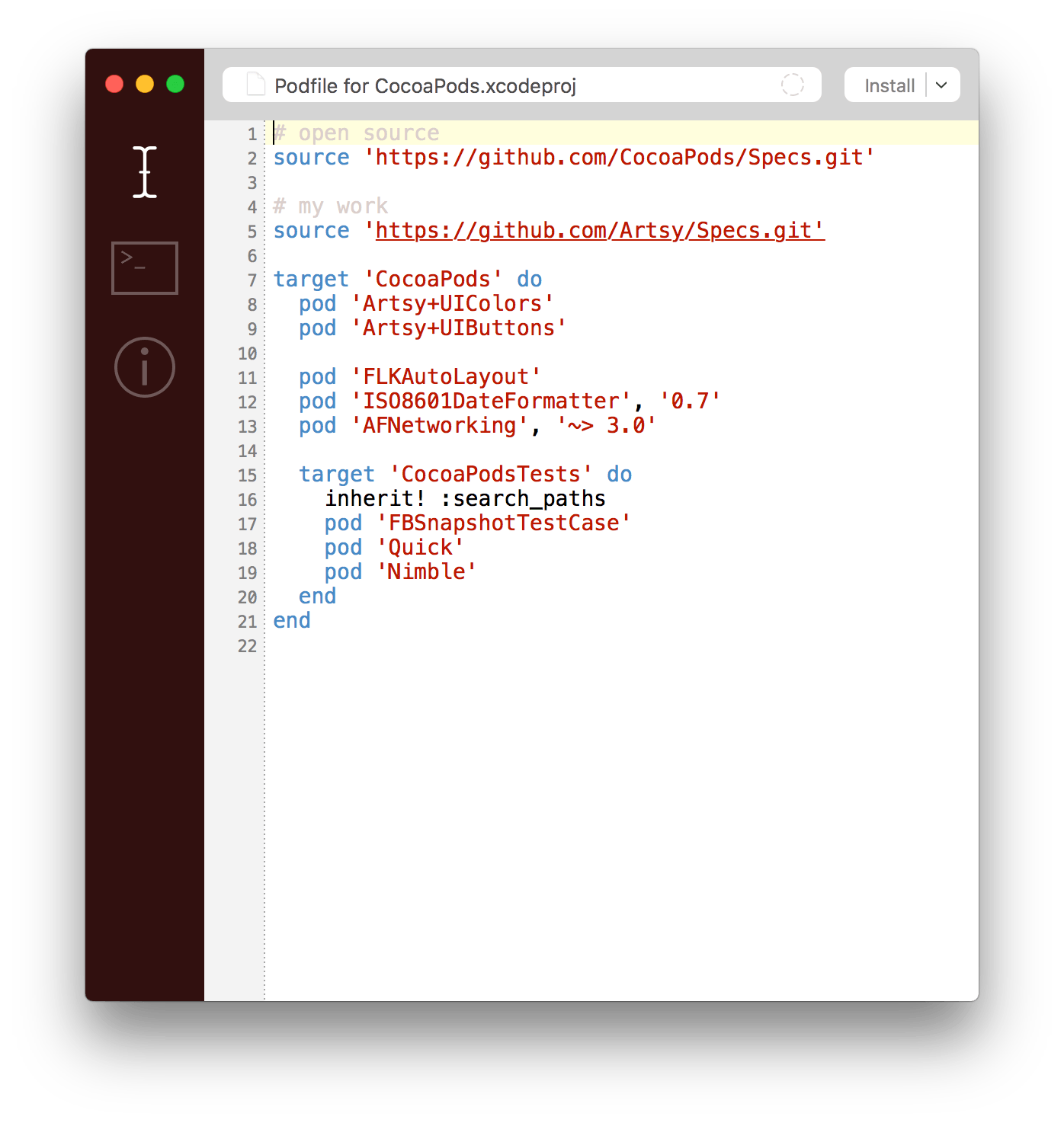Write a custom catalog title here
- Macos Catalina Install Cocoa Pods Online
- Macos Catalina Install Cocoa Pods Free
- Macos Catalina Install Cocoa Pods For Sale
Because the black apple system was reinstalled on the previous computer, CocoaPods was reconfigured
CocoaPods
What is CocoaPods?
- Unable to install Cocoapods on macOS Catalina 10.15.7 You’re now watching this thread and will receive emails when there’s activity. Click again to stop watching or visit your profile/homepage to manage your watched threads.
- Install Xcode command line tools: To install the latest version on Xcode you need to follow the below steps: Open Xcode - Preferences - Locations tab - install latest version of Xcode command line tools. Create your first react native project in MAC: Step 7. Run your created project.
ocoaPods is a tool responsible for managing third-party open source libraries in iOS projects. The source code of the CocoaPods project is managed on GitHub (https://github.com/CocoaPods).
The development of iOS projects inevitably requires the use of third-party open source libraries. When using third-party libraries, in addition to importing source code, integration of these dependent libraries also requires us to manually configure, and when these third-party libraries are updated, we also need It is very troublesome to update the project manually.
The emergence of CocoaPods allows us to save the time of setting up and updating third-party open source libraries. With CocoaPods, we can manage the third-party dependent libraries in a unified manner. Configuration and update only need to be completed with a few simple lines of commands.
Why use CocoaPods?
Open the disk image, then open the.pkg installer inside the disk image. It installs an app named Install Version Name. Open that app from your Applications folder to begin installing the operating system. MacOS Sierra 10.12 can upgrade El Capitan, Yosemite, Mavericks, Mountain Lion, or Lion. MacOS Catalina, macOS Mojave, ormacOS High Sierra Installers for each of these macOS versions download directly to your Applications folder as an app named Install macOS Catalina, Install macOS Mojave, or Install macOS High Sierra. If the installer opens after downloading, quit it without continuing installation.
Before using CocoaPods, when a development project needs to use a third-party open source library, we need to:
Copy the source code of the open source library into the project
Add some dependent frameworks and dynamic libraries
Set -Objc, -fno-objc-arc and other parameters
Manage their updates

After using CocoaPods, we only need to put the used open source libraries in a file named Podfile, and then execute pod update. CocoaPods will automatically download the source code of these third-party open source libraries and provide it for us Set the corresponding system dependencies and compilation parameters for the project.
The principle of CocoaPods
The principle of CocoaPods is to put all dependent libraries in another project called Pods, and then let the main project depend on the Pods project, thus moving the source code management work from the main project to the Pods project.
Macos Catalina Install Cocoa Pods Online
Third-party libraries will be compiled into .a static libraries or .framwork dynamic link libraries for our real projects.
CocoaPods will combine all third-party libraries into a project named Pods in the form of targets, which will be placed in the newly generated Pods directory. The entire third-party library project will generate a static library named libPods.a for our project to use.
For resource files, CocoaPods provides a bash script named Pods-resources.sh, which will be executed every time the project is compiled, copying various resource files of third-party libraries to the target directory.
The original project settings have been changed. At this time, if we directly open the original project file to compile, an error will be reported. The Pods project where our project and third-party library are located will be organized and managed in the form of a newly generated workspace, which is convenient for us to intuitively manage the project and third-party library.
CocoaPods uses a file named Pods.xcconfig to set all dependencies and parameters at compile time
CocoaPods installation steps
Ruby environment
1. Set up ruby source
The ruby environment that comes with the Mac system will be installed
1.1, check the ruby source of your computer
ruby -v
Legend has it that the minimum version of ruby supported by CocoaPods is 2.2.2. If your computer version is lower than this version, you can upgrade ruby. The above shows that my computer version does not need to be upgraded. You can ignore the following upgrade operation
sudo gem update --system
1.2 Replace ruby mirror
Ruby's default original address is a foreign network address. Use the following command to view the current mirrorgem sources -l
Remove current mirrorgem sources --remove https://rubygems.org/
Macos Catalina Install Cocoa Pods Free
Add domestic ruby mirrorgem sources -a https://gems.ruby-china.com/
Check the current mirror again and find that it has been replaced successfully
CocoaPods installation
Before Mac OS X 10.11sudo gem install cocoapods
Macos Catalina Install Cocoa Pods For Sale
After Mac OS X 10.11sudo gem install -n /usr/local/bin cocoapods
Since the system of this machine is 10.15, choose the latter command inputsudo gem install -n /usr/local/bin cocoapods
2.2, check whether the installation is successful

pod search AFNetworking
I actually looked at this blog configuration at the beginning, but at this step I found that there seems to be a problem
Opened the website https://git.coding.net/CocoaPods/Specs.git
found this look
But the principle is
The Podspec files of all projects are hosted at https://github.com/CocoaPods/Specs. When pod setup is executed for the first time, CocoaPods will update these podspec index files to the local ~/.cocoapods/ directory. This index file is relatively large, about 80M.
And I guess the reason for this is to clone the code of this repository
CocoaPods/Specs
https://github.com/CocoaPods/Specs.git
But the clone code from git is quite full, so it is put on coding, but this warehouse is out of date or private.
So I cloned a warehouse on Code Cloud

After changing the code link, it succeeded and the speed flew up